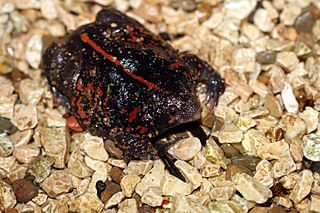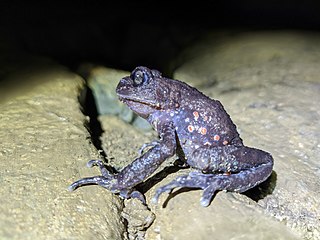
A tadpole is the larval stage in the biological life cycle of an amphibian. Most tadpoles are fully aquatic, though some species of amphibians have tadpoles that are terrestrial. Tadpoles have some fish-like features that may not be found in adult amphibians such as a lateral line, gills and swimming tails. As they undergo metamorphosis, they start to develop functional lungs for breathing air, and the diet of tadpoles changes drastically.

The Mexican burrowing toad is the single living representative of the family Rhinophrynidae. It is a unique species in its taxonomy and morphology, with special adaptations to assist them in digging burrows where they spend most of their time. These adaptations include a small pointed snout and face, keratinized structures and a lack of webbing on front limbs, and specialized tongue morphology to assist in feeding on ants and termites underground. The body is nearly equal in width and length. It is a dark brown to black color with a red-orange stripe on its back along with splotches of color on its body. The generic name Rhinophrynus means 'nose-toad', from rhino- (ῥῑνο-), the combining form of the Ancient Greek rhis and phrunē.

Eastern spadefoot toads comprise a genus of the family Megophryidae in the order Anura, and are found in southern China, northeast India, southeast Asia, and islands of the Sunda Shelf as well as the Philippines. They are characterized by a stocky body with slender, short hindlimbs. In identifying species, iris colour is a valuable diagnostic morphological characteristic ; the iris has uniform colour in some species, whereas in other species the upper half is coloured and the lower half is dark.

Gastrophryne carolinensis, the eastern narrow-mouthed toad, is a species of microhylid frog. It is a relatively small, toad-like amphibian found in damp, shady habitats. The species is highly fossorial, and feeds primarily on ants. These North American microhylids are distinguished from true toads, and other anurans by their moist, smooth skin, their lack of eardrums or tympana, their distinguishable squat body shape, and the unique fold of skin superior to their eyes. It is found in the United States, from southern Maryland to the Florida Keys, west to Missouri and Texas. While not a true toad, it is so called because it is terrestrial.

Leptobrachium hasseltii is a species of toad found in Southeast Asia. This frog named after Dutch Naturalist Johan Conrad van Hasselt. According to the current understanding, this species is known with certainty only from Java, Madura, Bali, and Kangean Islands, Indonesia. The species is also commonly reported to occur in the Philippines, but these are believed to refer to another, unnamed species.

Itapotihyla is a genus of frogs in the family Hylidae. It is monotypic, being represented by the single species Itapotihyla langsdorffii, commonly known as the ocellated treefrog. It is found in the Atlantic Forest biome of Brazil, with an isolated population in eastern Paraguay and adjacent Brazil and northeastern Argentina.

Hyperolius spinigularis is a species of frog in the family Hyperoliidae. It is found in the Mulanje Massif in southern Malawi and the Namuli Massif in adjacent Mozambique. Records from Tanzania refers to other species. Males of this species have characteristic small spines during the breeding season. Its common names are spiny-throated reed frog, spiny reed frog, and Mulanje reed frog.

Hyperolius tanneri is a species of frogs in the family Hyperoliidae. It is endemic to the West Usambara Mountains in northeastern Tanzania. Common name Tanner's reed frog has been coined for this species.

Leptobrachium hendricksoni is a species of amphibian in the family Megophryidae. It is found in Malay Peninsula, Sarawak (Borneo), and Sumatra (Indonesia). Its natural habitats are tropical moist lowland forests, rivers, freshwater marshes, and nearby plantations and heavily degraded former forests. It is threatened by habitat loss.

Leptobrachium montanum is a species of frog from the family Megophryidae. It is endemic to Borneo and is, as currently defined, found in Kalimantan (Indonesia), Sabah and Sarawak (Malaysia), and Labi, Belait (Brunei). However, the nominal Leptobrachium montanum is a composed of more than one lineage. Available information mostly refers to this composite rather than the "true" Leptobrachium montanum. Common names montane large-eyed litter frog, mountain spadefoot toad, and mountain litter frog have been coined for it.
Oreolalax major is a species of amphibian in the family Megophryidae. It is endemic to China and found in Sichuan and Yunnan provinces, between Mount Emei and Hengduan Mountains. It likely exists in Emeishan, Wawushan, Gonggashan, Wolong, and Dujiangyan National Nature Reserves. Its natural habitats are subtropical moist montane forests and rivers. It is threatened by habitat loss.
Oreolalax multipunctatus is a species of amphibian in the family Megophryidae. It is endemic to the Mount Emei region in Emeishan and Hongya counties of Sichuan, China. Its natural habitats are subtropical moist montane forests and rivers. It is threatened by habitat loss.
Oreolalax pingii is a species of amphibian in the family Megophryidae. It is endemic to south-western China where it is restricted to the Daliang and Hengduan Mountains in Sichuan and Yunnan. Its natural habitats are subtropical moist montane forests, moist shrubland, and rivers. It is threatened by habitat loss.

Oreolalax rhodostigmatus is a species of amphibian in the family Megophryidae. It is endemic to central and south-central China where it can be found in Hubei, Sichuan, Guizhou, and Hunan provinces. While its distribution is relatively wide, it is known from only few locations. Its natural habitats are limestone caves in forested habitats. Breeding takes place in springs and stream pools inside the limestone caves. It is threatened by habitat loss and locally by collection for food (tadpoles).
Leptobrachium ailaonicum is a species of amphibian in the family Megophryidae. It is found in Yunnan in southern China and on Fansipan mountain in northern Vietnam. Its type locality is Xujiaba in the Ailao Mountains in Jingdong County, Yunnan. At the time of the IUCN assessment in 2004, the population on Fansipan was considered a separate species, Leptobrachium (Vibrissaphora) echinatum, and assessed to be an endangered species.
Leptobrachium liui, the Chong'an moustache toad or Pope's spiny toad, is a species of frog in the family Megophryidae.
The Omei horned toad, also known as the Mount Omei spadefoot toad, is a species of frog in the family Megophryidae. It is found in Sichuan and Tibet in China, including the type locality, Mount Emei and possibly in Vietnam. Its natural habitats are subtropical or tropical moist lowland forests, subtropical or tropical moist montane forests, and rivers. It is threatened by habitat loss.
The Emei music frog is a species of frog in the family Ranidae. It is endemic to China, and is found in central China, in southeastern Sichuan, northeastern Yunnan and western Guizhou provinces. The species name refers to the type locality, Mount Emei in Sichuan, and its vocalizing abilities. The original name Rana musica was replaced with Rana daunchina as the former name was already taken.
The Omei brown frog or Omei wood frog is a species of frog in the family Ranidae. It is endemic to central China. Its name refers to Mount Emei, its type locality. Its natural habitats are hill forests and grass clumps in forests. Breeding occurs in late summer and the tadpoles overwinter; the breeding habitat is standing water. It is not considered threatened by the IUCN.
Leptobrachium promustache is a species of frog in the family Megophryidae. It is only known from Hekou and Pingbian counties in southern Yunnan, China, and from Lào Cai Province in adjacent northwestern Vietnam. Common name primary moustache toad has been proposed for it.












